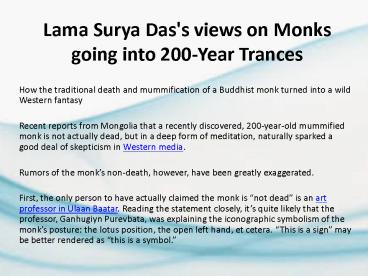Lama Surya Das's views on Monks going into 200-Year Trances - PowerPoint PPT Presentation
Title:
Lama Surya Das's views on Monks going into 200-Year Trances
Description:
Recent reports from Mongolia that a recently discovered, 200-year-old mummified monk is not actually dead, but in a deep form of meditation, naturally sparked a good deal of skepticism in Western media. – PowerPoint PPT presentation
Number of Views:22
Title: Lama Surya Das's views on Monks going into 200-Year Trances
1
Lama Surya Das's views on Monks going into
200-Year Trances
- How the traditional death and mummification of a
Buddhist monk turned into a wild Western fantasy - Recent reports from Mongolia that a recently
discovered, 200-year-old mummified monk is not
actually dead, but in a deep form of meditation,
naturally sparked a good deal of skepticism in
Western media. - Rumors of the monks non-death, however, have
been greatly exaggerated. - First, the only person to have actually claimed
the monk is not dead is an art professor in
Ulaan Baatar. Reading the statement closely, its
quite likely that the professor, Ganhugiyn
Purevbata, was explaining the iconographic
symbolism of the monks posture the lotus
position, the open left hand, et cetera. This is
a sign may be better rendered as this is a
symbol.
2
(No Transcript)
3
Second, it is a common practice in Vajrayana
Buddhism (which includes most forms of Tibetan
Buddhism, as well as many found in Mongolia) for
the bodies of well-known teachers to be entombed
sitting in lotus position, and preserved in salt.
Indeed, most of the past Dalai Lamas have been
preserved in this way, and can be seen to this
day in the Potala Palace in Lhasa. It would not
be unusual for a respected Vajrayana teacher to
be buried in this way. So where has all this
not deadjust meditating stuff come
from? There are no Zombie Lamas, said Lama
Surya Das, a Western-born Tibetan lama who has
written several bestselling books on contemporary
spirituality. These arent just superstitions
from the old worldthat this person is immortal
in his mummy-body. The point is that this monk
was an enlightened meditation master who
approached death consciously and with intention,
who died in meditation, in posture, sitting
up. Following death, Surya Das explained, is
the traditional period of tukdam, in which the
body is biologically dead but the mind may or may
not be. Tuk means Buddha-mind, and dam means
one with. So tukdam is absorption in the
Buddha-mind.
4
Tukdam starts when death occurs, and remains for
some timea few days, a week or two at the most.
Eventually, the body slumps, and starts decaying,
and its packed in salt and preserved. Most
likely, this process is what took place in the
case of the Mongolian monk. He entered a state of
deep meditation, died, and then resided in the
post-death tukdam state before being preserved.
5
I asked Surya Daswho Ive known for many years
and who, perhaps uniquely among certified Tibetan
lamas, speaks with a strong Brooklyn accent and
peppers his speech with jokeswhat the purpose of
such a bizarre practice might be. For the dying
person, Surya Das explained, the point is to
practice the teachings, point the way, model
another way of being and of conscious dying and
transitioning, and thus benefit all beings,
especially his followers. In other words, its
one final act of teaching showing how powerful
contemplative practice can be, how it is possible
to meditate even on ones final breath. And for
the community, Surya Das drew an analogy to
preserving the bones and relics of the great
Catholic saints. Essentially, he said, people
have traditionally believed that physical remains
embody or carry some of the spiritual essence and
blessings of the original saintly or sagely holy
person. So the body was left, as the master
died that way, intentionally and purposefully
seated in meditation, even after his tukdam was
complete and the signs of physical death
manifested more vividly.
6
Nor are such practices only maintained in the
steppes of Mongolia. Amazingly, Surya Das said
that he most recently witnessed a tukdam right in
New York City, in the summer of 2014, when the
widow of a famous lama passed away, and sat in
tukdam for ten days to two weeks, while various
rituals were performed. In a nice touch, this all
took place at a Buddhist center on West 16th
Street, just a couple of blocks from The Daily
Beasts office. Kenneth Folk, a well-known
American Buddhist meditation teacher, had a
somewhat more cynical view of the media coverage.
We in the West are often fascinated by Eastern
thought, especially Buddhism, and many of us have
fallen in love with the image of the Tibetan
monk, he said. The exaggeration in Western media
is part and parcel of an orientalist fascination
with those wonderful cave-dwelling
ascetics. For contemporary teachers like Folk,
the real question is the opposite What are the
real nuggets of Buddhist thought and practice
that stick around even after we let go of magical
thinking?
7
This was Surya Dass point as well. This is not
about zombiesalthough what is a zombie, really?
Does it refer to the walking dead, or walking
around in this world without a heart or soul?
That is the real question. And to that, a
200-year-old mummy provides no answers. Article
Source - https//suryadas017.wordpress.com/2015/02
/09/lama-surya-dass-views-on-monks-going-into-200-
year-trances/































